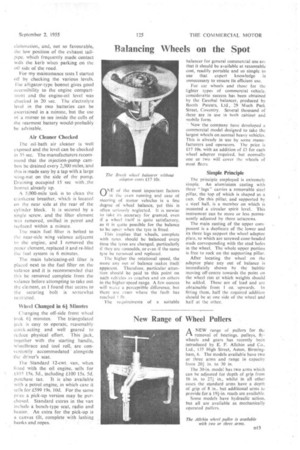Balancing Wheels on the Spot
Page 53

If you've noticed an error in this article please click here to report it so we can fix it.
QNE of the most important factors in the even running and ease of steering of motor vehicles is a line degree of wheel balance, yet this is often seriously neglected. It is unwise to take its accuracy for granted, even if a wheel itself is quite satisfactory, as it is quite possible for the balance to be upset when the tyre is fitted.
This implies that wheels, coniplete with tyres. should be balanced every time the tyres are changed, particularly if they are remoulds, or even if the same tyre be removed and replaced.
The higher the rotational speed, the more any out of balance makes itself apparent. Therefore, particular attention should be paid to this pointon such vehicles as coaches and on others in the higher-speed range. A few ounces will make a perceptible difference, but there are cases where the fault has reached I lb.
The requirements of a suitable balancer for general commercial use arc that it should be available at reasonable cost, readily portable and so simple to use that expert knowledge is unnecessary to ensure its efficient use.
For car wheels and those for the lighter types of commercial vehicle, considerable success has been obtained by the Easobal balancer, produced by Booth. Patents, Ltd., 29 Much Park Street, Coventry. Several thousand of these are in use in both cabinet and .nobile form.
Now the company have developed a commercial model designed to take the largest wheels on.normal heavy vehicles. This is already in use by some manufacturers and operators. The price is £17 10s. with an addition of £5 for each wheel adaptor required, but normally one or two will cover the wheels of most fleets.
Simple Principle
The principle employed is extremely simple. An aluminium casting with three " legs " carries a removable steel pillar, the top of which is shaped as a cup. On this pillar, and supported by a steel ball, is a member on which is mounted a circular spirit level, This instrument can be more or less permanently adjusted by three setscrews.
The main casting of the upper component is a duplicate of the tower and its three legs support the wheel adaptor plate, to which are screwed cone-headed studs corresponding with the stud holes in the wheel. The whole upper portion is free to rock on the supporting pillar.
After locating the wheel on the adaptor plate any out of balance is immediately shown by the bubble moving off-centre towards the point on the wheel rim at which weights should be added. These are of lead and are obtainable from 1 oz. upwards. In .fitting them, half the required addition should be at one side of the wheel and half at the other.
















































































































